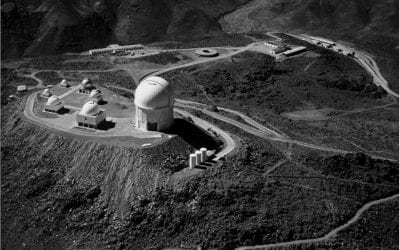The Sky Within Reach
Democratization of the Cosmos

This cluster of galaxies in the constellation centaurus is more easily seen from the southern hemisphere. ctio 4-meter blanco telescope, 1975. Photo courtesy of NOAO/AURA/NSF.
In 2009 we celebrate the international year of astronomy and commemorate the work of Galileo Galilei, theorizing that the earth and the planets orbited around our sun. And now, 200 years later, we are exploring a new field, that of extra-solar planets. The study of our sky above is considerably more democratized than in Galileo’s time; informal students of astronomy and even amateur astronomers are part of the process with some interesting collaborations.
To date, more than 330 detected planets orbit stars other than our sun dozens to thousands of light years away. The first discovery is considered by many to be that of Michael Mayor and Didier Queloz from the Geneva observatory in 1995, when they detected a Jupiter-like planet around a typical star named Pegasi 51. Since then, aside from making numerous discoveries, astronomers have measured the masses and radii of more than 50 planets, detected the atmospheres of a few, and even image directly two systems.
And this process of learning showed us, to our surprise, that some of our theories were biased. In fact, in hindsight, the first discovered planet was HD 114762b. In 1989 Harvard Professor David Latham and colleagues had reported the existence of an object that at the time was difficult to accept as a true planet. As Latham explained to me in an analogy with baseball, the discovery had three strikes against it: the planet was 11 times the mass of Jupiter, and this made it too massive to safely be considered a planet at the time; its period was 84 days, thought to be too short for such a massive object; and the eccentricity was 0.35, too large from the solar system experience. We now understand this planet to not be uncommon. There are bigger planets, more eccentric planets and planets with much smaller periods. In truth, the discovery of exoplanets has shown us how biased our expectations were and that nature is extremely diverse.
Until a few years ago, the detection of planets was a job reserved exclusively for highly-educated research astronomers. Nowadays, a new trend has emerged as our understanding on how to find other solar systems has improved: amateur astronomers are also contributing to the quest of planet hunting and confirming the detections. The confirmation of a planet after discovery is almost as important as the discovery itself. While discovering a planet is quite difficult for amateur astronomers (given the low occurrence of events, so that thousands of stars need to be monitored), follow-up is relatively easy. There have been successful collaborations and two big active groups are: the Transit Search network lead by Greg Laughlin, an astronomy professor at the University of California, Santa Cruz (www.transitsearch.org), and the microFUN group led by Andrew Gould, a professor of astronomy from Ohio State University (www.astronomy.ohio-state.edu/~microfun). Amateurs are at the heart of these collaborations and in several cases have contributed crucial data.
The detection methods monitor the candidate star through different methods and look for indirect effects caused by the presence of an unseen planet. The radial velocity method measures the wobble of the star as the planet orbits around it, while the transit method measures the dimming of light as the planet passes in front of the star. The combination of the two yields the mass and radius of the planet. These two methods favor the detection of short-period planets. The third successful method, microlensing, is sensitive to planets that are farther away. The presence of a star with a planet within the line of sight of a background star will cause the light to bend with a distinct signal indicating the presence of a companion.
Even though most of the discovered exoplanets are Jupiter-like (planets with massive H and He atmospheres), there are a few smaller, also very interesting objects. Going down in mass, there are a few Neptune-like planets with intermediate atmospheres, and about a dozen super-Earths, which we expect to be mostly solid. The term super-Earths has been coined for those planets that have an incipient or no atmosphere at all. They might resemble the Earth and the Terrestrial planets, or the icy satellites. You can tell why these are interesting objects—some of these might harbor life.
Among these, the remarkable planet CoRoT-7b is the first super-Earth with a measured radius. The modest French-led space mission CoRoT reported in February 2009 having detected the first transiting super-Earth. Its size amounts to 1.7 times that of Earth. It has a mass less than 11 times that of Earth and a whopping period of less than one day! The proximity to its star makes this planet nothing like Earth. However, its very discovery is a positive sign because despite of sitting at the detection limit of CoRoT, the signal is distinct. We can safely expect many more super-Earths to be detected in the very near future with the recently launched U.S. space mission Kepler. Its goal is to detect an earth-mass planet around a sun-like star at a one-year orbit.
We are definitely getting closer to detecting an Earth analog, and that opens a whole set of questions. The obvious one, might there be life? Many of us scientists are working hard at eventually answering this question. And while we look for a true Earth-analog, we will discover larger and more massive versions of Earth and the icy satellites first, the so-called super-Earths. As a PhD student at the Earth and Planetary Sciences department at Harvard and now as a postdoctoral fellow at the Observatoire de la Cote d’Azur, I have studied the structure, composition and thermal evolution of these planets, called exceptional in that they do not exist in our solar system. And the goal of all of us who are studying them is to also learn more about our planet and our neighbors.
As the next decade unfolds many more discoveries, we will learn more about stars, planets, and, in general, about our home on the earth in the context of the universe. As we celebrate the year of astronomy, lets’ celebrate the efforts by men and women to understand the sky above us, from the professional astronomers, to the amateurs, to the those training the future generation of scientists.
Spring 2009, Volume VIII, Number 3
Diana Valencia received her doctorate from the Earth and Planetary Sciences department at Harvard University and is currently a postdoctoral fellow at the Observatoire de la Cote d’Azur.
Related Articles
Sustaining Life: How Human Health Depends on Biodiversity
n September 2004, Hurricanes Jeanne and Ivan struck the Caribbean and southern United States in rapid succession. Damage to Haiti in the West Indies was particularly severe. High…
Making a Difference: The Cartonera Comes to Mexico
Chalco is one of Mexico City’s poorest neighborhoods, far enough away from the center along the traffic-clogged highway to Puebla to feel isolated as well as arid. There, migrants from…
An Astronomical Scene
Where can you find an Italian professor teaching an American student in Spanish using lecture slides written in English? In the astronomy course I took at Chile’s Pontifícia Universidad Católica (PUC)…




